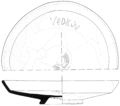AO·3
| Inscription | |
|---|---|
| Reading in transliteration: | ụerkọu |
| Reading in original script: | |
| Variant reading: | ụericọu ụedicọu |
|
| |
| Object: | AO·3 Aosta (bowl) |
| Position: | bottom, inside |
| Orientation: | 0° |
| Direction of writing: | dextroverse |
| Script: | prob. North Italic script |
| Number of letters: | 6–7 |
| Number of words: | 1 |
| Number of lines: | 1 |
| Workmanship: | unknown |
| Condition: | complete, damaged |
|
| |
| Archaeological culture: | La Tène D 2 [from object] |
| Date of inscription: | 1st c. BC [from object] |
|
| |
| Type: | unknown |
| Language: | Celtic |
| Meaning: | 'Uerkou' (?) |
|
| |
| Alternative sigla: | Morandi 2004: 44 |
|
| |
| Sources: | Morandi 2004: 546 no. 44 |
Images
Commentary
First published in Mollo Mezzena 1994: 162–169.
Image in Mollo Mezzena 1994: 163, fig. 25d (drawing; also visible in the photo 25f).
Inscribed on the inside bottom of the patera near the rim. Initial upsilon and omicron are damaged by breaks. After rho, a straight hasta and curved line can be interpreted either as a single letter kappa ![]() , which is securely attested in this form in the Celtic part of the Todi inscription, or as two letters
, which is securely attested in this form in the Celtic part of the Todi inscription, or as two letters ![]()
![]() . In the first case, the reading is straight-forward Lepontic uerkou (thus Marinetti & Prosdocimi 1994: 44). Final -⟨ou⟩ is most likely a Greek-influenced spelling for the on-stem nom. sg. ending -ū as in Gallo-Greek (cf. Marinetti & Prosdocimi 1994: 44 f. and NM·9 and NM·13). In the second case, the presence of Latin gamma
. In the first case, the reading is straight-forward Lepontic uerkou (thus Marinetti & Prosdocimi 1994: 44). Final -⟨ou⟩ is most likely a Greek-influenced spelling for the on-stem nom. sg. ending -ū as in Gallo-Greek (cf. Marinetti & Prosdocimi 1994: 44 f. and NM·9 and NM·13). In the second case, the presence of Latin gamma ![]() makes the reading of the third letter somewhat uncertain: it could still be Lepontic rho, if
makes the reading of the third letter somewhat uncertain: it could still be Lepontic rho, if ![]() is a simple Latinising letter substitution for kappa (uericou, thus Morandi). Since
is a simple Latinising letter substitution for kappa (uericou, thus Morandi). Since ![]() is never reliably attested in inscriptions which are otherwise written in the Lepontic alphabet, the third letter could in this case also be interpreted as Latin delta (uedicou). The inscription would then be written in Latin script with Lepontic reminscences in the oblique bars of epsilon and angular shape of omicron, in which case final -⟨ou⟩ would have to be explained as an orthographic compromise between the vernacular Celtic on-stem ending -ū and the equivalent Latin ending -ō. Under the assumption that final -⟨ou⟩ ultimately reflects -ū in any case, all three forms can be analysed as personal names (see the word pages).
is never reliably attested in inscriptions which are otherwise written in the Lepontic alphabet, the third letter could in this case also be interpreted as Latin delta (uedicou). The inscription would then be written in Latin script with Lepontic reminscences in the oblique bars of epsilon and angular shape of omicron, in which case final -⟨ou⟩ would have to be explained as an orthographic compromise between the vernacular Celtic on-stem ending -ū and the equivalent Latin ending -ō. Under the assumption that final -⟨ou⟩ ultimately reflects -ū in any case, all three forms can be analysed as personal names (see the word pages).
